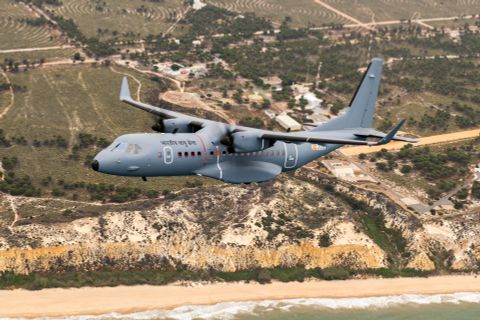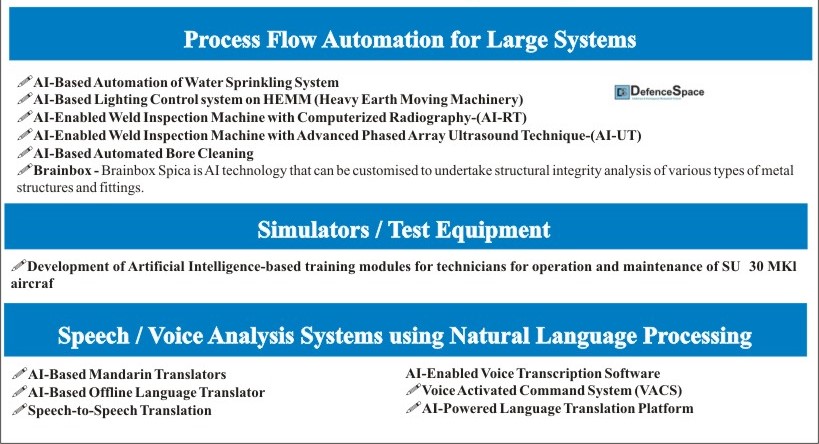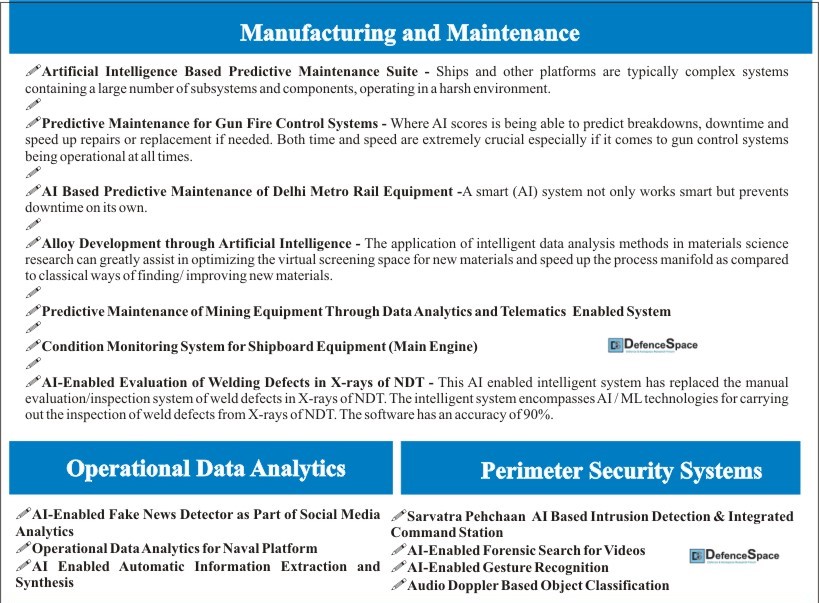An Article by Ritika Behal
Unprecedented growth in the civil aviation sector and modernization of the Armed Forces has opened many windows of MRO opportunities for energizing the aerospace industry. The author discusses in detail the growing global and Indian MRO aircraft market.
Aircraft MRO is the overhaul, repair, inspection or modification of an aircraft or aircraft component to keep it operational and airworthy.
The MRO ecosystem, basically comprises of OEMs, airline operators, service providers, vendors, and manufacturers of parts/spares.
There is no scope of doubt that the growth in both civil and military aviation is accentuating the demand for MRO facilities which has become an indispensable activity of air assets in the aviation industry.
Also, it is worth mentioning that the expenditure incurred by airlines on MRO accounts for 12-15 per cent of the overall revenues, and with a 3-5 per cent increase per annum
Notably, this is the second-highest expense after fuel cost (45% of operating expenses).
GLOBAL AIRCRAFT MRO MARKET
MRO today is a multi-billion-dollar industry growing at a robust rate year-on-year.
The global aircraft MRO industry was valued at USD 78.60 billion in 2022 and is expected to reach USD 122.14 billion by 2030, growing at a Compound Annual Growth Rate (CAGR) of 5.02% during the mentioned period (2023-2030), as per a recent report by Grand View Research.
Some of the global key players and prominent vendors in the MRO market are BAE Systems, Boeing, Airbus, General Dynamics, Lockheed Martin, Huntington Ingalls Industries, Northrop Grumman, Raytheon, Rockwell Collins, Saab, URS Corporation, and Elbit Systems, etc.
To be noted that the MRO industry is highly regulated and comprises routine checks, repair and scheduled replacement of components, and maintenance during redelivery of an aircraft with the primary purpose of maintaining ‘airworthiness’ of the aircraft.
MRO Segmentation. According to a report by NITI Aayog, MRO services are categorized into four major segments: -
- Engines Maintenance and Auxiliary Power Units (APU)
- Line Maintenance
- Component Maintenance
- Base Maintenance
Figure below provides a brief overview of the four major segments of the MRO industry.
Of these four segments, Engine and APU maintenance constitute almost 60% of the total MRO cost, whereas component, line and base maintenance form around 22%, 8% and 10% respectively
Notably, Engine and APU maintenance is majorly done in the USA, as airlines find it more competitive there as compared to other destinations.
Further, it is to be noted that out of the above-mentioned segments, airframe maintenance is labor-intensive in nature, with labour cost occupying up to 80% of the total cost incurred during an aircraft’s maintenance.
On the other hand, engine maintenance is extremely capital-intensive, with a major portion (~80%) of the overall cost being occupied by the cost of spares.
In component MRO services, labour cost and cost of spares occupy 45% and 55% of the overall cost respectively.
The approximate share of labour and spares cost of major MRO segments has been depicted in the below given Figure.
INDIAN AIRCRAFT MRO MARKET: A WHOOPING $7 BN OPPORTUNITY
India has a rapidly growing MRO market and the coming years will see substantial growth in this segment.
The exponentially rising civil aviation industry coupled with the ongoing procurements and future requirements of Indian Armed Forces represents a strong case for the development of the MRO industry in India.
Figure below provides a comparative analysis of the annual growth rate of the MRO sector in India vis-à-vis other key countries/regions.
India can ensure substantial advancements by developing a sustainable end-to-end ecosystem for commercial, general and military
MRO activities.
The benefits would potentially include reduction in foreign exchange outflow, greater employment opportunities and
augmentation of domestic MRO capability. Refer below given Table.
Indian Civil Aircraft MRO Market
The civil aircraft Maintenance, Repair and Overhaul (MRO) industry of India is at a nascent stage constituting less than 1 per cent of the total global MRO market.
Though India is seen as the fastest growing aviation market, it is ironic that the MRO market which services these very planes is still dependent on foreign countries for MRO services.
Currently, more than 80% of business generated by Indian civil / commercial airlines are being carried out overseas by large MRO companies in Singapore, France, Jordan, Germany, Turkey, Sri Lanka, Malaysia United Arab Emirates, and the USA.
The market size of the MRO sector in India stood at USD 1.7 billion in 2021, which is expected to reach USD 4.0 billion by 2031, registering a CAGR of 8.9% as compared to the global average of 5.9%.
Rising consumer demand, increasing fleet size, favorable policy interventions and labour arbitrage are some of the key factors that can potentially fuel growth and development of MRO services in India being procured from domestic MROs.
Key Players in the Indian MRO Market
Currently the market is concentrated with eight (8) major players namely, Air India Engineering Services Ltd (AIESL), Max MRO Pvt. Ltd., Air Works India (Engineering) Pvt. Ltd., Deccan Charters Ltd., Indamer Aviation Pvt. Ltd., Taj Air, Bird ExecuJet, and GMR Aero Technic Ltd
These companies capture more than half of market revenue with most of these players providing line maintenance, heavy maintenance, and component overhaul.
Apart from the above-mentioned key industry players, DGCA has also approved 40 overseas entities to conduct MRO on Indian registered aircrafts.
Worth mentioning that India is one of the fastest growing aviation markets in the world and is already the third largest domestic civil aviation market, after China and the United States (US).
At present, around 729 aircraft are operating in the civil / commercial space in India, and the fleet is likely to is likely to more than double to 1,600 in the next seven-eight years, as the Ministry of Civil Aviation.
Consequently, the MRO activities will be witnessing a significant growth in coming years in India
Further, there is no major helicopter MRO facility in India except for Pawan Hans and DPSU Hindustan Aeronautics Limited (HAL).
Helicopter MRO services is therefore a significant business opportunity with considerable potential for the future.
Thus, the need of the hour is to have a strong domestic MRO industry which has become a critical need and not just desirable.
MRO Maintenance Checks
A key aspect of aircraft maintenance is the nature and periodicity of various checks that an aircraft goes through.
Different aircrafts may require maintenance checks at different intervals depending on OEM guidance and domestic regulations.
Noteworthy, in India the “A” and “B” checks (Line Maintenance/Components) are mostly performed inhouse by the Indian airlines/operators as a part of their daily and weekly aircraft operations and being done by their own personnel or personnel contracted specifically for the task.
While, the “C” and “D” checks (Engine/Airframe/Heavy Maintenance) usually require more labor and are infrastructure intensive.
Thus, these tasks are outsourced to 3rd party MRO players usually connected with the OEMs.
The largest providers typically offer the four main MRO capabilities: Engines, Airframe, Component Services and Line/Modifications/Field Maintenance.
Noteworthy, the Engine Maintenance makes up the largest proportion of the Indian MRO market (47%), followed by Component (18%) and Line Maintenance (18%) followed by Airframe Heavy Maintenance and Modification (18%).
The revenue from Airframe Heavy Maintenance and Modifications has generated the least share since in India, very few companies provide Heavy Maintenance service because it requires approvals from a lot of global OEM’s and Regulators.
Most of the air operators prefer to avail Heavy Maintenance Service from abroad because of globally certified quality.
Drivers and Restrains of Indian MRO Market
India has a great potential to become a global MRO hub, however, undeniably it does need more Government support.Notably, the Indian government has introduced several policies over the past years to realize its vision of making the country a global MRO hub. Some of the major ones include:
- Lowering the Goods and Services Tax (GST) on domestic MRO services from 18% to 5%, with full input tax credit.
- Treating transactions sub-contracted by foreign OEMs and MRO companies to domestic MROs as exports with zero-rated GST
- Introduction of land lease via open tenders instead of predetermined rates to lower rental costs
- Exempting the 13% royalty charged by government authorities on revenue
- Exempting MRO service providers from customs duties on aircraft parts and tool kits and extension of storage period for aircraft spares to up to three years.
- Allotting land to MRO service providers for 30 years instead of the current three to five years.
- Permitting 100% foreign direct investment through the automatic route.
- Extending duty-free component imports for MRO from one to three years.
- Permitting foreign aircrafts to visit India for MRO for a six-month period rather than a 15-day period.
- Offering land allotments for MRO facilities for 30 years rather than 3-5 years
All of these are marked at integrating Indian MRO with the global value chain; however, it will be a long process as India still needs to address may other issues faced by the Indian MRO providers.
For instance, Indian MROs face considerable barriers to break into the existing value chains, involving OEMs, internationally established MROs, and airline operators.
Obstructions are also faced with respect to implementation of offset clauses, credit accessibility, availability of infrastructure, licensing and certification, taxes/duties, and highest taxes on jet fuel as compared to any other country in the world, to name a few.
Indian Military Aircraft MRO Market
Defence platforms and systems are subjected to periodic maintenance throughout its entire service life.
Rather, in many Armed Forces globally one third to half of the total capability of key asset classes is out of action for maintenance at any time undertaken in-house or outsourced or combination of both.
Thus, it would not be wrong to say that MRO has become a priority for Armed Forces worldwide as it not contributes to the preparation of forces but also as well as the accomplishment of operations or fulfillment of operational contracts.
Amongst all the platforms, it is the Aero / Aircraft Platforms MRO that accounts for the largest share due to huge requirements.
Furthermore, in a typical Armed Service, MRO accounts for more than 10 percent of the total defence budget and as much as 70 percent of all aircraft related costs.
MRO, basically aims at the correction of defects, of the effects of aging on the aircraft (corrosion, wear-and-tear, technical obsolescence) and of the effects of usage (breakdowns, replacement of consumable items).
The objective is to have aircraft available at the right time to meet operational requirements.
Therefore, it is normal that Armed Forces seek to maximize the availability of their equipment while managing the associated costs.
Noteworthy, the share represented by MRO throughout the life cycle of a product is often greater than that of the acquisition costs.
Nowadays, the high acquisition cost of new equipment is driving the militaries for opting out for lifecycle extension of their aero assets.
While the operating cost remains relatively consistent, it is the MRO/Logistics cost that increases year on year and drives the in-service cost.
Rather, over the extended life of an aircraft/military platform, the MRO Expenditure/Sustainment – phase represents 70-80 percent of the entire system lifecycle.
Refer Fig. which is based upon assumed typical military aircraft unit acquisition cost is around $150 Million.
In India, the overhaul and maintenance/repair of various types of military aircrafts is taken care by the nine Base Repair Depots under Maintenance Command which include:
- 1 Base Repair Depot Kanpur-Chakeri - Various Overhaul
- 2 Base Repair Depot Gwalior-Maharajpur - Various Overhaul
- 3 Base Repair Depot Chandigarh - Mi-8, Mi-17, Mi-25, Mi-35 Overhaul
- 4 Base Repair Depot Kanpur-Chakeri - Various Overhaul
- 5 Base Repair Depot Coimbatore-Sulur - Various Overhaul
- 7 Base Repair Depot Tughlakabad- New Delhi - Various Missile System
- 9 Base Repair Depot Pune, - Various Overhaul
- 11 Base Repair Depot Ojhar - MiG-23, MiG-29 Overhaul
- 18 Base Repair Depot Jodhpur - MiG-21 Overhaul
Apart from the above mentioned BRDs, MRO is also provided by DPSU chiefly Hindustan Aeronautics Ltd (HAL) and Bharat Electronics Ltd, for some of the aircraft fleets and systems; mainly those that are licensed produced or manufactured by them) such as MRO for KIRAN-I/IA, KIRAN-II, JAGUAR, MIRAGE, MiG - 21 BISON, DO-228, HS-748, AN-32 and Helicopter MRO for ALH, Cheetah and Chetak.
Furthermore, IAF is also still dependent on foreign OEMs for some of the legacy equipment as well as recently inducted weapon platforms and systems.
In case of foreign OEM there may be a long-term repair contract or annual maintenance contract. MRO by foreign companies is cost prohibitive and time consuming.
There are still a few Line-Replaceable unit (LRUs) i.e., components of aircrafts, spacecrafts, or artificial satellites that can be replaced at the operational site to ensure unhindered functioning; especially for the recently inducted aircraft fleets and systems, for which Repair and Overhaul facilities are yet to be established within the country.
The three Defence Services have wide and varied inventory of Aircrafts, instrumentation systems and weaponry procured from various countries and periodic maintenance is required to keep them operational.
However, this is a huge challenge primarily due to technological obsolescence coupled with rapidly diminishing product support from the OEM.
Lessons learnt from the unavailability of spares for India’s Russian aircraft, which have often been grounded for long periods.
These include Sukhoi Su-30MKIs and various MiG fighter aircraft, the Ilyushin Il-76 and Antonov An-32 transport aircraft and various helicopter types.
With aging/obsolete platforms and equipment being used by the Armed Forces, as well as the procurements of new advanced systems, the requirement for more robust MRO capabilities is increasing.
Rather, there is an urgent need to tackle obsolescence in the defence sector with almost 5-6 percent of the existing platforms every year need to be replaced as compare to normal cases, wherein only around 3-4 per cent is required to be replaced.
This shows that the maintenance/service area needs to be dealt swiftly as obsolescence cannot be wiped off immediately.
The Booming Military MRO Market of India
The defense / military MRO market of India is expected to be worth $3 billion by 2031 growing at a CAGR of 6%. to service India’s fleet of around 2060+ aircraft.
The MRO spending for these older aircraft is significant because of low reliability and obsolete parts. The base repair depots require additional support to cater to the growth in requirements.
It needs no underlining that India has a huge requirement of military aircrafts and helicopters.
Rather, as per rough estimates, the country is expected to buy approximately 1000+ numbers of aircraft and helicopters in the Defence sector in the next seven to ten years.
This will further be escalated coupled with a substantial number of UAVs/drones which are to be procured.
And, the price tag of these procurements in pipeline is expected to be worth $40-50 billion approx., and the value of maintenance work typically is equivalent to about 40% of the purchase price according to estimates from the MRO Association of India.
Accordingly, this means around $16-20 billion will be spent on India on Defence MRO and related activities in next seven-ten years.
Thus, the requirement of the overhaul is seen to go up.
Additionally, there will be production technology, automation, simulation, and upgradation creating a huge potential for maintenance actives.
This multi dollar opportunity will pave way for the private sector companies in India for providing MRO services as HAL which currently undertake overhaul of most of the military aircrafts is gradually getting overloaded with increasing fleet inventory.
With the changing times, the concept of indigenization in IAF has been transformed into a broader idea that enables participative collaboration with Indian industry – with both public and private companies.
The core MRO capability of the Air Force Base Repair Depots could function as an interface with the private industry.
The Indian Air Force has also started showing interest in outsourcing most of its MRO requirements to privately-owned companies in the country.
As per estimations, outsourcing the Indian Air Force’s maintenance needs to private sector alone might create a $3 billion industry.
WAY FORWARD
To sum it up the Indian and global aviation industry, both civil and defence is on the verge of a taking an enormous leap with growing demand of both static and rotary aircrafts opening many windows of MRO services especially for the private sector.
Furthermore, with the increase in the number of civil and military aircrafts in coming years, more and more global MRO companies are planning to offer MRO services by forming joint ventures with Indian firms.
The manufacturers nowadays are offering serviceability (sometimes 70-80 per cent) along with its purchase enabling it to be operational at all times so for them to have an Indian JV partner becomes imperative.
As for India, incremental steps such as joint ventures with established global MRO players, focus on MRO segments with lower IP control (electrical and electronics, avionics, structural repair, etc.) and a gradual shift towards the higher end of the MRO value chain (such as manufacture of landing gears, etc.) is recommended in order to establish a robust MRO industry in the country.





One thought on “Aircraft MRO Market: An Outlook”
Comments are closed.